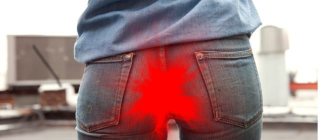Why is the procedure performed?
Currently, a cleansing enema before childbirth is not a mandatory event. The woman herself makes the decision about the procedure. There are several points that indicate the benefit (and in some cases, the need) of cleansing immediately before labor.
Reference! Now before childbirth, instead of an enema, a more convenient and safe option is used - microenemas. A popular representative is Microlax.
Factors in favor of conducting a cleansing enema before childbirth in the maternity hospital:
- After cleansing, more space appears in the pelvic area. This is good because nothing interferes with the child’s exit. But a crowded intestine is a serious obstacle, which complicates the work of obstetricians and the woman’s condition.
- The intestines and uterus are connected by the nervous system. When the intestines are stimulated, the same thing happens to the uterus; contractions occur, promoting the opening of the cervix.
- Aesthetics. During passage to the exit, the fetal head presses on the intestines, which becomes a factor in bowel movement during childbirth. The woman in labor may be concerned about this fact, but this does not affect the process itself.
- Before a cesarean section, this will be an important event, because a full intestine becomes an obstacle to the surgical operation.
There are also facts that refute the need for an enema:
- cleansing the intestines does not affect the duration of the birth process;
- a full intestine does not always interfere with the operation; in case of emergency intervention, the procedure is not performed;
- an enema can cause constipation after childbirth;
- fecal matter comes out before the baby’s head appears, so dirt can be removed in time to clean the birth site.
How to help your intestines function normally
If difficult bowel movements occur after a cesarean section, it is imperative to take measures to eliminate it. If you cannot improve the condition on your own, you need to visit a doctor, because when feces stagnate, the body releases toxins that harm the entire body as a whole.
Due to regular abdominal pain, poor nutrition and constant discomfort, the lactation process may stop completely, and the symptom will develop further, causing various complications.
There are several effective ways to solve constipation problems after cesarean section while breastfeeding.
Medicines to relieve the condition
Most medications for the treatment of constipation after cesarean section are not suitable for breastfeeding. Therefore, the selection of drugs should be carried out only by a specialist.
Having different therapeutic effects, drugs with a laxative effect are classified into groups:
- agents with a laxative effect: castor oil, senna herb, buckthorn, sodium, bisacodyl, picosulfate. They help to cope with the problem of constipation, but are contraindicated during lactation, since they contain substances hazardous to the child’s health;
- drugs that soften the intestinal contents: gel or liquid hydrocarbons - Norgalax (microenemas) and petroleum jelly (for oral administration). The use of enemas is a more suitable procedure after a cesarean section, as it has a local effect. Vaseline oil has contraindications - during breastfeeding;
- agents that increase the volume of feces: Naturolax, Mucofalk. These medications are based on plantain and flax seeds, so they can be taken even while breastfeeding;
- osmotic laxatives (saline) - their principle of operation is based on fluid retention in the intestines. Breastfeeding women are prohibited from taking Fleet phospho-soda and magnesium sulfate, as they can change the taste of milk, which increases the risk of the baby refusing to breastfeed. Other drugs belonging to this group can be used during lactation, these include Lactulose (Normaze, Duphalac), Macrogol, Actipol;
- topical preparations are microenemas (Microlax) and various suppositories (glycerin). These drugs have an effective effect on intestinal receptors. These are the most harmless drugs prescribed after cesarean section while breastfeeding.
Treating constipation without medications
Eliminating constipation with folk remedies alleviates symptoms and helps with bowel movements.
Traditional recipes for constipation:
- Herbal decoction. A decoction of a mixture of fennel seeds, cumin and anise helps to perform the act of defecation. They are taken in equal proportions and steamed with a glass of boiling water. The mixture is kept in a thermos for 3-4 hours. Take 1/4 cup several times a day.
- Fig decoction. Figs (fresh) are finely chopped and poured with warm water or milk. Leave for about an hour and drink 1 tablespoon several times a day.
- Herbal infusion. A collection of chamomile, strawberries, nettles and valerian root is effective against constipation. Herbs are mixed in equal parts. 2 tbsp. spoons of the mixture are steamed with a glass of boiling water. Leave in a thermos for several hours and drink in two doses.
- Enema with vegetable oil. One of the effective proven means for normalizing intestinal activity.
- Eat on an empty stomach a salad of grated beets, crushed nuts (any) with kefir, a handful of prunes. All of these remedies help with constipation after cesarean section.
What else should you do if you have constipation after a cesarean section?
Special exercises alleviate the condition and help with constipation:
- lie on your right side;
- gently pull your left leg towards your chest;
- Stay in this position for at least five minutes.
Doing this exercise daily helps improve intestinal motility and helps release accumulated gases.
Nutritional Features
After a caesarean section, a woman must first normalize her diet, while taking into account the possible manifestation of allergic reactions in the baby. You should also drink 1.5-2 liters of liquid daily, this will ensure the normal functioning of the digestive system.
After a cesarean section, doctors recommend including the following foods in your diet:
- fruits and berries: apricots, melon, prunes, green apples, cherries;
- cereals: pearl barley, buckwheat, rolled oats, types of breads from coarse varieties of wheat;
- vegetable crops: carrots, white cabbage, Chinese cabbage, radishes, turnips, broccoli;
- fermented milk products: cottage cheese, low-fat kefir, fermented baked milk, Varenets;
- vegetable oils;
- drinks: green tea, compotes from dried apples and dried apricots.
After a caesarean section, it is worth introducing restrictions on such products as potatoes, peas, beans, semolina and pearl barley porridge, white varieties of rice, pears, strawberries, blueberries, cheese, nuts, and bread made from premium wheat flour. You will also have to give up black tea and coffee.
Features of Microlax
Microlax is a colorless liquid for rectal administration. The solution is viscous and consists of sodium citrate, sorbitol, sodium lauryl sulfoacetate. One enema consists of 5 ml of the substance. The solution is contained in a small tube with a tip for easy administration.
The use of Microlax before childbirth is due to its laxative effect. The solution increases the amount of fluid, which helps ease emptying. The effect occurs approximately 10 minutes after the procedure.
A microenema is applied rectally, the contents of one tube are introduced at a time, the tip is inserted to its entire length, which is 60.6 mm.
There is a possibility of developing the following adverse reactions from Microlax:
- pain in the abdominal area;
- loose stools;
- discomfort in the anal area;
- hypersensitivity reaction.
Side effects occur extremely rarely; the use of microenemas in pregnant women is completely safe. If you are allergic to the components, you should avoid the procedure. Before use, consult with your doctor.
Microlax has many advantages:
- hygiene – the microenema contains a small amount of substance, it does not require preliminary antiseptic treatment and is immediately ready for use;
- speed of onset of effect - the drug acts very quickly, the first urge appears within 5-15 minutes, the substance softens stool, facilitating easy bowel movements;
- safety – Microlax can be used before childbirth without risks, it will not harm the woman or the unborn child in any way;
- has no age restrictions for use;
- ease of use - the tube is ready for use, no need to worry about additional products and devices.
Before surgery
Firstly, it is better to go to the maternity hospital in advance, at least 1-2 days in advance. During this time, you will get used to the hospital atmosphere, pass all the tests, and meet the doctor. You will also chat with other girls waiting for their “finest” hour. Their support and advice will be very helpful in the future.
Secondly, prepare for surgery. Morally! Calm down, get a good night's sleep the night before; If you can't sleep, ask the nurse for some sedative. Also pack the bag in the recovery room. You will need a bottle of mineral water without gases, a mug, clean panties (preferably with a high elastic band so that they don’t put pressure on the seam), pads, and a phone.
An anesthesiologist will visit you on the eve of the operation. Answer all his questions, tell him about all the illnesses and injuries that you have had during your life. This could be very important. Ask any questions you have about anesthesia. Personally, I chose epidural anesthesia because... it does not affect the child, it is easier to get back on your feet later, doctors can always find out about your well-being from you and, most importantly, you will immediately see your child and hear his first cry!
With general anesthesia, the child is more lethargic, you will see him only after you wake up. And this is fraught with psychological difficulties - for some it will be difficult to realize that this is their baby, and all because they did not see the moment of his birth. And this is already scary! I will write further, implying that the anesthesia is local.
Thirdly, nutrition on the eve of surgery. You can have a hearty breakfast, a light lunch without meat, until 6 pm you can have kefir and yogurt. After 6 only water, tea without sugar. It is recommended to drink at least 1.5 liters of liquid.
Fourthly, an enema. It is recommended to do it in the evening and morning before surgery. But you can only get by in the morning if you ate a little yesterday.
Fifth, you will have to shave. So don't forget a disposable razor.
How to do an enema
An enema can be performed at home or in a hospital. The procedure should be done in the maternity hospital during the first birth. If a woman has already given birth, you can give a microenema at home, coming to the delivery room already prepared.
When determining the time needed for carrying out, the following factors are taken into account:
- the onset of contractions and dilation of the uterus;
- breaking of water;
- prolapse of the abdomen.
Such signs will be a reason to carry out a cleansing procedure before childbirth. In the maternity hospital, this is done in a special room where the woman can carry out hygiene procedures. Also, cleansing can be carried out in the hall itself, depending on the circumstances.
Conducted in a clinical setting
Algorithm and features of setting Microlax microenemas in a maternity hospital under the supervision of doctors:
- Hygiene procedures are carried out.
- The protective seal is removed from the tube.
- A small amount of product is squeezed out to provide lubrication.
- The tip is inserted into the anus while lying on your side or squatting.
- The solution is injected with a sharp movement.
- After insertion, the anal sphincter muscles should be squeezed.
- Lie down until the first urge.
After administering Microlax, it is advisable to lie down for proper distribution of the substance. It is best to raise your pelvis a little by placing a pillow.
Carrying out at home
At home, microenemas are carried out according to the same principle. Before administering the drug, you need to thoroughly clean the anal area and wash your hands with soap. It is important to insert the tip completely for proper delivery of the medication.
How to prevent bowel problems after cesarean section
It’s worth thinking about how to improve your stool after a caesarean section from the first day in the maternity ward. They help with enemas and medications. But then the woman herself must take care of timely bowel movements.
Several aspects are important for this:
| What is needed | Recommendations |
| Nutrition | You should eat meals hourly and use the right foods. These are boiled vegetables, fruits, bran bread, fermented milk drinks. |
| Liquid | You should definitely drink a lot of water to start your day. In the morning, you can add lemon juice to a glass of liquid. And the total daily volume should be at least 2 liters. |
| Movement | You need to get up the very next day after a cesarean section. In the future, no matter how much you want peace, you need to walk and do feasible exercises to strengthen your abdominal muscles. |
| Exercise for the intestines | There is an exercise that helps strengthen his motor skills. You need to lie on your right side, pulling your left knee towards your stomach. The right lower limb should be extended. If you take this position 3 to 5 times a day, the pressure on the large intestine will increase, which stimulates its activity. |
Reviews
Microenema Microlax receives positive reviews from women and doctors. The good attitude towards the drug is due to its fast action and safety.
Some women note the lack of results. This is influenced by many factors, including improper use. The cause of ineffectiveness can also be problems with the intestines, chronic constipation, which must be dealt with before the planned birth.
Microlax can be a good solution for cleansing the intestines before childbirth. It is important to follow the instructions and consult a doctor, then the desired effect will be obtained.
Causes of the problem
Constipation after cesarean section is provoked by many forced circumstances:
- weakness of the abdominal muscles due to stretching and injury;
- changes in the location of the intestines;
- decreased organ motility;
- passive behavior of a young mother;
- improper and insufficient nutrition;
- damage to some parts of the intestine (fissures);
- the occurrence of hemorrhoids;
- a small amount of fluid consumed by a woman;
- fear of defecation caused by the presence of sutures on the uterus and abdominal wall.
Many of the reasons for disruption of the digestive system are caused by hormonal changes.
How to distinguish the causes of pain when going to the toilet
Many young mothers who have undergone a cesarean section themselves provoke disturbances in the functioning of their internal organs. One of the most common causes is constipation, which occurs due to the fear of hurting oneself. A woman, even with a natural urge to defecate, may not go to the toilet on time. We have already partially discussed this issue in the article gases and fecal incontinence after childbirth.
Perhaps an attempt was made that was unsuccessful due to pain in the intestinal area. It is often confused with the pain of postoperative sutures. You can determine what hurts—the stitch or the intestines—by the signs characteristic of each. The pain in the intestines is dull in nature - it occurs due to straining during the act of defecation.
This is important: If there is no stool for several days after a cesarean section, be sure to tell your doctor about the troubles. While in the hospital, the woman in labor is prescribed electrical stimulation of the intestines.
If there is pain and there is no stool, we can safely talk about the development of constipation. Also, constipation is characterized by bloating of the abdomen with increased secretion of gases or their complete absence. The pain from the suture is sharp and occurs when changing position; it is almost impossible to confuse it. When sitting on the toilet, you may experience severe pain not in the entire abdominal area, but only at the location of the suture after a cesarean section.
Enema before caesarean section
The birth of a child through surgical intervention is being practiced more and more often. The reasons for this decision are varied. The main factors leading to the inevitability of a CS:
- The risk of a threat to the health and life of the baby during natural childbirth.
- There is a high risk of loss of health or death of the mother if the child is allowed to be born independently.
As a rule, this operation is planned. The exception is natural childbirth with complications, when only a CS can save the mother and baby.
Any surgical intervention involves performing enema procedures and cleansing the intestines of contents. An enema before a cesarean section will avoid unplanned penetration of feces into the wound and the development of secondary infection. Additionally, an enema before childbirth greatly facilitates the postpartum period and speeds up recovery.
CS is a violation of the integrity of the skin of the abdomen, the inner layer of the epidermis and the uterus. In the first postoperative days, attempts to tense the abdominal muscles will be painful, even when taking painkillers. Therefore, a clean intestinal tract will eliminate the need to visit the toilet on these days and will reduce pain until the stitches are completely healed.
Also, performing forced cleansing of the intestinal tract during cesarean section has a preventive effect. After childbirth or surgery, it is often observed that women cannot go big. Fecal masses release toxins and gases, bloating and pain occur, inflammatory processes develop, and the risk of complications increases.
Enema and childbirth
In the Soviet Union, all maternity hospitals adopted the practice that cleansing the intestines before childbirth is mandatory. And today, most maternity hospitals continue to perform enema procedures for pregnant women. It is worth noting that the obligation to carry out the procedure is excluded, solely by voluntary consent.
The manipulations take a little time. Execution is carried out using standard methods. To do this, the woman lies on her side. In the absence of discomfort, a pregnant woman can get on all fours. The tip of a rubber hose is inserted into the rectum, and liquid is gradually poured in. You need to wait 10 minutes. and go to the toilet. If emptying is not complete, repeat the procedure.
There is no pain when administering an enema. A discomfort may occur. To eliminate unpleasant sensations, you need to do the following:
- Get information about the location of the toilet so you don't have to search.
- When fluid enters the rectum, the muscles relax, leaving room for free penetration into the canals. The process will go faster and easier.
- After finishing the enema, you should squeeze the anus, not allowing the solution to come out prematurely.
- Calm down, remove the fear of the enema. The volume of fluid injected is not as large as it might seem at the beginning of the procedure.
- In order for all the contents to come out of the intestines, you need to spend a little more time in the toilet.
However, not all pregnant women undergo a forced bowel cleansing procedure. Eg:
- The maternity hospital does not practice this procedure.
- Labor is of an emergency nature.
- Late arrival of the woman in labor on the territory of the maternity home, the baby is already leaving, there is no time for enema procedures.
- A pregnant woman has complications that do not allow colon cleansing, as well as contraindications to enema procedures.
When a doctor directs a woman in labor to undergo procedures, she expects positive results. Goals of enema:
- The birth process will be easier, labor will be calmer due to the absence of feces in the intestines.
- During childbirth, fetal movement becomes freer, fecal stones do not interfere with the baby’s progress towards the exit.
- The expectant mother is not distracted by the state of her intestines, but is completely focused on the birth of the child.
When is it necessary to contact a proctologist?
Most women manage to get rid of constipation with the help of medications or folk advice. However, some experience complications such as:
- severe pain in the peritoneum;
- feces with blood;
- defecation delay for more than 2 days;
- More than 3 weeks have passed since birth, but difficulties with bowel movements remain.
If one of the signs is identified, you should contact a proctologist, because this may be a symptom of a serious disease (intestinal obstruction, tumor, adhesions). The doctor will prescribe an effective laxative that will help get rid of the problem.
Atonic constipation
Atonic constipation occurs due to decreased muscle tone of the intestinal walls. Thus, peristalsis becomes unproductive and too weak.
The manifestation of muscle flaccidity is a fairly common reaction of the intestines to surgical interventions, or it occurs at a time when the diet is disrupted.
Symptoms
Symptoms of the disease are divided depending on the type of stool retention. There are atonic and spastic constipation.
With atonic constipation, there is a decrease in the muscle tone of the intestine and the impossibility of normal movement of feces. The main symptoms of this condition are:
- constant feeling of fullness in the intestines;
- aching, pressing pain in the abdomen;
- increased gas formation;
- decreased patient activity;
- headache.
Spastic constipation occurs most often for psychological reasons associated with changes in status and fear of the difficulties of caring for a child. It is characterized by the following symptoms:
- the occurrence of pain more often in the left iliac region, which is periodic;
- You may experience nausea and, in rare cases, vomiting, which are caused by exposure to toxins formed in the intestines;
- lack of appetite;
- a feeling of frequent urge to defecate with the inability to stool;
- increased formation of gases in the intestines.
With atonic constipation, the stool has a dense consistency, and with spastic constipation, it resembles the appearance of goat droppings.
Spastic constipation
The appearance of this type of deviation from the norm follows the fact that the tone of the intestinal tract increases. This, in turn, leads to compression and permanent fixation of the passages. The cause of such unpleasant consequences is a psychological factor. This suggests that the woman experienced stress during childbirth and her psychophysical state was disturbed.
Diet after childbirth
A woman’s diet in the first 2-3 days should consist only of liquid food: still mineral water in large quantities, broths. Then, gradually, the young mother should switch to more solid foods, limiting the consumption of bread and flour products.
The main thing is that the food contains a large amount of fiber - it actively helps the intestines work and eliminates problems with stool. As you know, fiber is found in vegetables and fruits. Considering that almost all women breastfeed their babies, and it is extremely important not to cause allergies in the baby, choose “universal” fruits and vegetables. Moreover, this list may change depending on the season.
Vegetables and fruits, universal for nursing and non-breastfeeding mothers:
- Zucchini, pumpkin, broccoli, boiled carrots, eggplant, beets.
- Apples, pears, bananas, plums, currants, gooseberries, cherries.
Figs and prunes have a beneficial effect on intestinal function in the first days after childbirth (but you should be extremely careful with plums). And also olive or sunflower oil (1 tbsp per day). It is worth reassuring nursing mothers suffering from constipation: an imbalance in intestinal function does not affect the quality of breast milk.
And non-breastfeeding mothers can resume their normal diet within a week after giving birth.
, constipation due to fear is common . Until the stitches heal, the young mother thinks that something might happen during a bowel movement. This is not true: if doctors performed an operation and stitched for 6 days, this does not mean that you have to endure it and not go to the toilet until everything heals! If a woman cannot cope with her fears, nurses in the maternity hospital will help give a cleansing enema.











